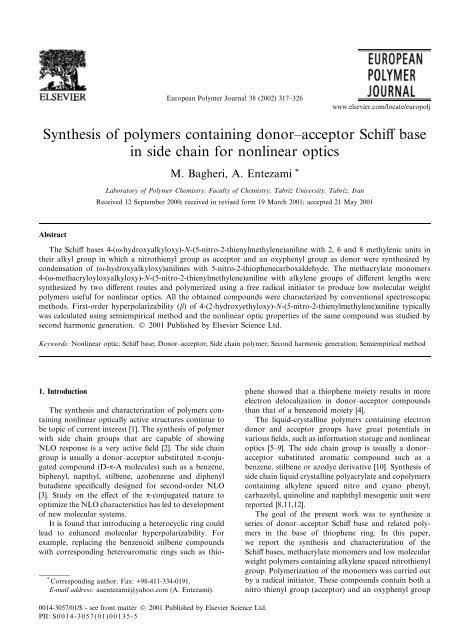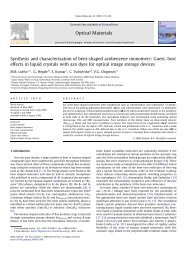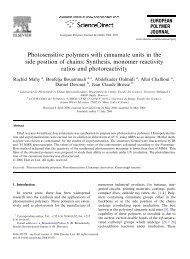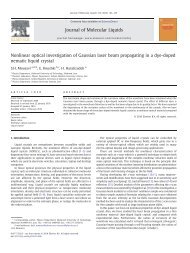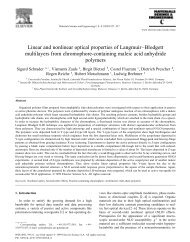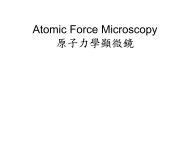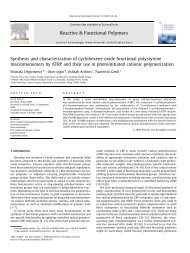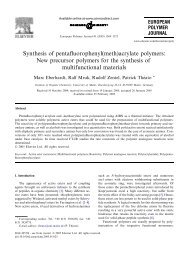Synthesis of polymers containing donor±acceptor Schiff base in side ...
Synthesis of polymers containing donor±acceptor Schiff base in side ...
Synthesis of polymers containing donor±acceptor Schiff base in side ...
Create successful ePaper yourself
Turn your PDF publications into a flip-book with our unique Google optimized e-Paper software.
<strong>Synthesis</strong> <strong>of</strong> <strong>polymers</strong> <strong>conta<strong>in</strong><strong>in</strong>g</strong> <strong>donor±acceptor</strong> Schi€ <strong>base</strong><br />
<strong>in</strong> <strong>side</strong> cha<strong>in</strong> for nonl<strong>in</strong>ear optics<br />
Abstract<br />
M. Bagheri, A. Entezami *<br />
Laboratory <strong>of</strong> Polymer Chemistry, Faculty <strong>of</strong> Chemistry, Tabriz University, Tabriz, Iran<br />
Received 12 September 2000; received <strong>in</strong> revised form 19 March 2001; accepted 21 May 2001<br />
The Schi€ <strong>base</strong>s 4-x-hydroxyalkyloxy)-N-5-nitro-2-thienylmethylene)anil<strong>in</strong>e with 2, 6 and 8 methylenic units <strong>in</strong><br />
their alkyl group <strong>in</strong> which a nitrothienyl group as acceptor and an oxyphenyl group as donor were synthesized by<br />
condensation <strong>of</strong> x-hydroxyalkyloxy)anil<strong>in</strong>es with 5-nitro-2-thiophenecarboxaldehyde. The methacrylate monomers<br />
4-x-methacryloyloxyalkyloxy)-N-5-nitro-2-thienylmethylene)anil<strong>in</strong>e with alkylene groups <strong>of</strong> di€erent lengths were<br />
synthesized by two di€erent routes and polymerized us<strong>in</strong>g a free radical <strong>in</strong>itiator to produce low molecular weight<br />
<strong>polymers</strong> useful for nonl<strong>in</strong>ear optics. All the obta<strong>in</strong>ed compounds were characterized by conventional spectroscopic<br />
methods. First-order hyperpolarizability b) <strong>of</strong> 4-2-hydroxyethyloxy)-N-5-nitro-2-thienylmethylene)anil<strong>in</strong>e typically<br />
was calculated us<strong>in</strong>g semiempirical method and the nonl<strong>in</strong>ear optic properties <strong>of</strong> the same compound was studied by<br />
second harmonic generation. Ó 2001Published by Elsevier Science Ltd.<br />
Keywords: Nonl<strong>in</strong>ear optic; Schi€ <strong>base</strong>; Donor±acceptor; Side cha<strong>in</strong> polymer; Second harmonic generation; Semiempirical method<br />
1. Introduction<br />
The synthesis and characterization <strong>of</strong> <strong>polymers</strong> <strong>conta<strong>in</strong><strong>in</strong>g</strong><br />
nonl<strong>in</strong>ear optically active structures cont<strong>in</strong>ue to<br />
be topic <strong>of</strong> current <strong>in</strong>terest [1]. The synthesis <strong>of</strong> polymer<br />
with <strong>side</strong> cha<strong>in</strong> groups that are capable <strong>of</strong> show<strong>in</strong>g<br />
NLO response is a very active ®eld [2]. The <strong>side</strong> cha<strong>in</strong><br />
group is usually a <strong>donor±acceptor</strong> substituted p-conjugated<br />
compound D-p-A molecules) such as a benzene,<br />
biphenyl, napthyl, stilbene, azobenzene and diphenyl<br />
butadiene speci®cally designed for second-order NLO<br />
[3]. Study on the e€ect <strong>of</strong> the p-conjugated nature to<br />
optimize the NLO characteristics has led to development<br />
<strong>of</strong> new molecular systems.<br />
It is found that <strong>in</strong>troduc<strong>in</strong>g a heterocyclic r<strong>in</strong>g could<br />
lead to enhanced molecular hyperpolarizability. For<br />
example, replac<strong>in</strong>g the benzenoid stilbene compounds<br />
with correspond<strong>in</strong>g heteroaromatic r<strong>in</strong>gs such as thio-<br />
* Correspond<strong>in</strong>g author. Fax: +98-411-334-0191.<br />
E-mail address: aaentezami@yahoo.com A. Entezami).<br />
European Polymer Journal 38 2002) 317±326<br />
0014-3057/01/$ - see front matter Ó 2001Published by Elsevier Science Ltd.<br />
PII: S0014 -305701)0013 5 -5<br />
www.elsevier.com/locate/europolj<br />
phene showed that a thiophene moiety results <strong>in</strong> more<br />
electron delocalization <strong>in</strong> <strong>donor±acceptor</strong> compounds<br />
than that <strong>of</strong> a benzenoid moiety [4].<br />
The liquid-crystall<strong>in</strong>e <strong>polymers</strong> <strong>conta<strong>in</strong><strong>in</strong>g</strong> electron<br />
donor and acceptor groups have great potentials <strong>in</strong><br />
various ®elds, such as <strong>in</strong>formation storage and nonl<strong>in</strong>ear<br />
optics [5±9]. The <strong>side</strong> cha<strong>in</strong> group is usually a donor±<br />
acceptor substituted aromatic compound such as a<br />
benzene, stilbene or azodye derivative [10]. <strong>Synthesis</strong> <strong>of</strong><br />
<strong>side</strong> cha<strong>in</strong> liquid crystall<strong>in</strong>e polyacrylate and co<strong>polymers</strong><br />
<strong>conta<strong>in</strong><strong>in</strong>g</strong> alkylene spaced nitro and cyano phenyl,<br />
carbazolyl, qu<strong>in</strong>ol<strong>in</strong>e and naphthyl mesogenic unit were<br />
reported [8,11,12].<br />
The goal <strong>of</strong> the present work was to synthesize a<br />
series <strong>of</strong> <strong>donor±acceptor</strong> Schi€ <strong>base</strong> and related <strong>polymers</strong><br />
<strong>in</strong> the <strong>base</strong> <strong>of</strong> thiophene r<strong>in</strong>g. In this paper,<br />
we report the synthesis and characterization <strong>of</strong> the<br />
Schi€ <strong>base</strong>s, methacrylate monomers and low molecular<br />
weight <strong>polymers</strong> <strong>conta<strong>in</strong><strong>in</strong>g</strong> alkylene spaced nitrothienyl<br />
group. Polymerization <strong>of</strong> the monomers was carried out<br />
by a radical <strong>in</strong>itiator. These compounds conta<strong>in</strong> both a<br />
nitro thienyl group acceptor) and an oxyphenyl group
318 M. Bagheri, A. Entezami / European Polymer Journal 38 2002) 317±326<br />
donor). The ®rst order hyperpolarizability b) calculation<br />
and second harmonic generation SHG) <strong>of</strong> Schi€<br />
<strong>base</strong> 4-2-hydroxyethyloxy)-N-5-nitro-2-thienylmethylene)anil<strong>in</strong>e<br />
<strong>in</strong> polymethylmethacrylate PMMA) matrices<br />
typically was studied by conventional apparatus.<br />
2. Experimental section<br />
2.1. Materials<br />
The purify<strong>in</strong>g or dry<strong>in</strong>g <strong>of</strong> compounds and solvents<br />
have been performed accord<strong>in</strong>g to the common procedure.<br />
4-Nitrophenol, 2-chloroethanol, 1,8-octanediol,<br />
Scheme 1. Synthetic route <strong>of</strong> PnTh n ˆ 2, 6 and 8).<br />
1,3-dibromopropane, stannous chloride and KHCO3<br />
were purchased from Merck. The thiophene-2-carboxaldehyde;<br />
1,6-hexandiol and sodium sul®de nonahydrate<br />
were purchased from Fluka. 1-Chloro-6-hexanol and<br />
1-chloro-8-octanol [13] were prepared accord<strong>in</strong>g to a<br />
literature procedure. The monomers and <strong>polymers</strong> were<br />
synthesized accord<strong>in</strong>g to the route outl<strong>in</strong>ed <strong>in</strong> Schemes 1<br />
and 2, and further details are given below. The chemical<br />
structures <strong>of</strong> the monomers are shown <strong>in</strong> Fig. 1.<br />
2.1.1. 5-Nitro-2-thiophene carboxaldehyde<br />
This compound was prepared as given <strong>in</strong> the literature<br />
[14]. Thus to HNO3 19.2 g, d ˆ 1:51) and 140 ml<br />
AcOH was added slowly 2-thiophenecarboxaldehyde
M. Bagheri, A. Entezami / European Polymer Journal 38 2002) 317±326 319<br />
Fig. 1. Structure <strong>of</strong> <strong>donor±acceptor</strong> monomers.<br />
26.9 g, 0.24 mol) <strong>in</strong> 85 ml Ac2O below 30 °C, the<br />
mixture stirred 0.5 h at 50±60 °C, quenched <strong>in</strong> ice 1h)<br />
and the diacetylated product washed with water. The<br />
crude material 31g) was treated with 140 ml H2O, 140<br />
ml EtOH, and 14 ml concentrated H2SO4, boiled for 0.5<br />
h, treated with charcoal, ®ltered hot and cooled. Then<br />
the ®ltrate was extracted with Et2O. The yellow needle<br />
crystals were recrystallized from 50% EtOH to give<br />
11.31 g 5-nitro-2-thiophene carboxaldehyde. Yield: 30%;<br />
mp ˆ 76 °C lit [17] mp ˆ 77±77.5 °C); IR KBr): 1670<br />
C@O), 1510 N@O), 1340 N@O) cm 1 .<br />
Scheme 2. Synthetic route <strong>of</strong> P3Th.<br />
2.1.2. 4-x-Hydroxyalkyloxy)anil<strong>in</strong>e [12]<br />
The synthesis <strong>of</strong> 4-8-hydroxyoctyloxy)anil<strong>in</strong>e is described<br />
as a representative case. 8-Chlorohexanol 39.5<br />
g, 0.24 mol) was added to a solution <strong>conta<strong>in</strong><strong>in</strong>g</strong> 4nitrophenol<br />
27.8 g, 0.2 mol) and KOH 16.8 g, 0.3 mol)<br />
<strong>in</strong> 150 ml <strong>of</strong> ethanol and water mixture 1:1). Then<br />
the mixture was re¯uxed for 48 h to give 17.5 g<br />
4-8-hydroxyoctyloxy)nitrobenzene. The result<strong>in</strong>g 4-8hydroxyoctyloxy)nitrobenzene<br />
17.37 g, 0.065 mol) was<br />
reduced with sodium sul®de nonahydrate 31.2 g, 0.13<br />
mol) <strong>in</strong> 150 ml 50% ethanol at re¯ux<strong>in</strong>g temperature for<br />
24 h. The crude product was recrystallized from toluene<br />
to give 12.26 g 4-8-hydroxyoctyloxy)anil<strong>in</strong>e. Yield:<br />
79.5%; mp ˆ 77 °C; FTIR KBr): 3362 O±H), 3323<br />
N±H), 3185 N±H) cm 1 ; 1 HNMR CDCl3): d 1.28±<br />
1.59 b, 13H, HOCH2CH2)6CH2), 1.76 m, 2H, NH2),<br />
3.66 m, 2H, CH2 ortho to OH), 3.94m, 2H, CH2OPh),<br />
6.66 d, 2H aromatic, ortho to O), 6.75 d, 2H aromatic,<br />
ortho to NH2); FTIR KBr): 3431 OH), 1619 C@N)<br />
cm 1 ; UV±VIS CH2Cl2): 421nm e ˆ 13,500).<br />
For other 4-x-hydroxyalkyloxy)anil<strong>in</strong>es, n ˆ 2:<br />
yield: 30%; mp ˆ 67 °C lit [15] mp ˆ 63:8 °C); FTIR<br />
KBr): 3450 OH), 3250, 3200 NH), n ˆ 6: yield: 65%;
320 M. Bagheri, A. Entezami / European Polymer Journal 38 2002) 317±326<br />
mp ˆ 75 °C lit [15] mp ˆ 75:7 °C); FTIR KBr): 3354<br />
OH), 3277, 3200 NH).<br />
2.1.3. 4-x-Hydroxyalkyloxy)-N-5-nitro-2-thienylmethylene)anil<strong>in</strong>e<br />
HnTh)<br />
5-Nitro-2-thiophene carboxaldehyde 4.7 g, 0.03 mol)<br />
was dissolved <strong>in</strong> 30 ml ethanol. After an equimolar<br />
amount <strong>of</strong> 4-x-hydroxyalkyloxy)anil<strong>in</strong>e was added to<br />
the ethanol solution, the mixture was heated at 70 °C for<br />
1h. The product was puri®ed by recrystallization from<br />
dichloromethane±petroleum ether 1:3, v/v) to provide<br />
HnTh.<br />
H2Th: Yield: 75% <strong>of</strong> brownish orange crystals;<br />
mp ˆ 125:4 °C; 1 HNMR CDCl3): d 3.88 m, 2H, CH2,<br />
ortho to OH), 4.2 t, 2H, CH2OPh), 6.95 d, 2H aromatic,<br />
ortho to O), 7.29 d, 2H aromatic, ortho to N),<br />
7.39 d, 1H aromatic, meta to NO2), 7.88 d, 1H aromatic,<br />
ortho to NO2), 8.53 s, 1H, N@CH); FTIR<br />
KBr): 3350 OH), 1614 C@N) cm 1 ; UV/VIS CH2<br />
Cl2): 413 nm e ˆ 10,600).<br />
H6Th: Yield: 90% <strong>of</strong> orange crystals; mp ˆ 99:6 °C;<br />
1 HNMR CDCl3): d 1.28 t, 1H, OH), 1.52 m, 4H,<br />
HOCH2)2CH2)2CH2)2), 1.64 m, 2H, HOCH2CH2),<br />
1.84 m, 2H, CH2CH2OPh), 3.69 t, 2H, CH2 ortho to<br />
OH), 4.01t, 2H, CH2OPh), 6.95 d, 2H aromatic, ortho<br />
to O), 7.31m, 3H aromatic), 7.91d, 1H aromatic,<br />
ortho to NO2), 8.57 s, 1H, N@CH); FTIR KBr): 3350<br />
OH), 1615 C@N) cm 1 ; UV±VIS CH2Cl2): 420.8 nm<br />
e ˆ 12,200).<br />
H8Th: Yield: 87% <strong>of</strong> yellowish brown crystals;<br />
mp ˆ 99:8 °C; 1 HNMR CDCl3): d 1.35±1.60 broad,<br />
9H, HOCH2)2CH2)4CH2), 1.78±1.82 m, 4H, HOCH2-<br />
CH2,CH2CH2OPh), 3.67 m, 2H, CH2 ortho to OH),<br />
4.01m, 2H, CH2OPh), 6.95 d, 2H aromatic, ortho to<br />
O), 7.31m, 3H aromatic), 7.91d, 1H aromatic, ortho<br />
to NO2), 8.57 s, 1H, N@CH); FTIR KBr): 3431OH),<br />
1619 C@N) cm 1 ; UV±VIS CH2Cl2): 421nm e ˆ<br />
13,500).<br />
2.1.4. 4-x-Methacryloyloxyalkyloxy)-N-5-nitro-2-thienylmethylene)anil<strong>in</strong>e<br />
MnTh)<br />
The synthesis <strong>of</strong> 4-6-methacryloyloxyhexyloxy)-N-<br />
5-nitro-2-thienylmethylene)anil<strong>in</strong>e is described as a<br />
representative case. H6Th 5 g, 0.017 mol) solution <strong>in</strong> 30<br />
ml dichloromethane was added to a solution <strong>conta<strong>in</strong><strong>in</strong>g</strong><br />
methacrylic acid 1.47 g, 0.017 mol), dicyclohexylcarbodiimide<br />
DCC), 3.53 g, 0.017 mol) and dimethylam<strong>in</strong>opyrid<strong>in</strong>e<br />
DMAP) 1.04 g, 0.0086 mol) <strong>in</strong> 50 ml<br />
dichloromethane at 0 °C. The reaction mixture was<br />
stirred for 20 h at room temperature. After work-up<br />
procedure, the product was puri®ed by recrystallization<br />
three times from ethanol to provide MnTh.<br />
M2Th: Yield: 76% <strong>of</strong> reddish orange crystals; mp ˆ<br />
148 °C; 1 HNMR CDCl3): d 1.89 s, 3H, CH3), 4.18 t,<br />
J ˆ 6:3, 2H, CH2OPh), 4.44 t, J ˆ 6:6, 2H, OCOCH2),<br />
5.53 s, 1H, HC@C), 6.08 s, 1H, HC@C), 6.9 d,<br />
J ˆ 8:6, 2H aromatic, ortho to O), 7.2 d, J ˆ 8:6, 2H<br />
aromatic, ortho to N), 7.26 d, J ˆ 7, 1H aromatic, meta<br />
to NO2), 7.82 d, J ˆ 7, 1H aromatic, ortho to NO2), 8.8<br />
s, 1H, N@CH). Anal. calcd. for C17H16N2O5S: C,<br />
56.65%; H, 4.48%; N 7.78%. Found: C, 56.04%; H,<br />
4.37%; N, 7.62%.<br />
M6Th: Yield: 80% <strong>of</strong> dark orange crystals;<br />
mp ˆ 97:8 °C; 1 HNMR CDCl3): d 1.52 m, 4H,<br />
OCOCH2)2CH2)2CH2)2), 1.74 m, 2H, OCOCH2CH2),<br />
1.82 m, 2H, CH2CH2OPh), 1.96 s, 3H, CH3), 4.0 t,<br />
J ˆ 6:3, 2H, CH2OPh), 4.19 t, J ˆ 6:6, 2H, OCOCH2),<br />
5.56 s, 1H, HC@C), 6.11 s, 1H, HC@C), 6.94 d,<br />
J ˆ 8:7, 2H aromatic, ortho to O), 7.31d, J ˆ 8:7, 2H<br />
aromatic, ortho to N), 7.34 d, J ˆ 7, 1H aromatic, meta<br />
to NO2), 7.92 d, J ˆ 7, 1H aromatic, ortho to NO2),<br />
8.57 s, 1H, N@CH). Anal. calcd. for C21H24N2O5S: C,<br />
60.56%; H, 5.81%; N, 6.73%. Found: C, 59.99%; H,<br />
5.76%; N, 6.76%.<br />
M8Th: Yield: 82% for brownish red crystals;<br />
mp ˆ 96:5 °C; 1 HNMR CDCl3): d 1.41±1.55 m, 8H,<br />
OCOCH2)2CH2)4CH2)2OPh), 1.70 m, 2H, OC-<br />
OCH2CH2), 1.82 m, 2H, CH2CH2OPh), 1.97 s, 3H,<br />
CH3), 4.00 m, J ˆ 6:3, 2H, CH2OPh), 4.16 t, J ˆ 6:6,<br />
2H, OCOCH2), 5.56 s, 1H, H2C@C), 6.12 s, 1H,<br />
H2C@C), 6.95 d, J ˆ 8:6, 2H aromatic, ortho to O),<br />
7.30 d, J ˆ 8:6, 2H aromatic, ortho to N), 7.34 d,<br />
J ˆ 7, 1H aromatic, meta to NO2), 7.92 d, J ˆ 7, 1H<br />
aromatic, ortho to NO2), 8.57 s, 1H, N@CH). Anal.<br />
calcd. for C23H28N2O5S: C, 62.14%; H, 6.55%; N,<br />
6.31%. Found: C, 61.57%; H, 6.71%; N, 6.38%. FTIR<br />
KBr) for MnTh: 1719 C@O), 1618 C@N) cm 1 .<br />
2.1.5. 4-3-Bromopropyloxy)nitrobenzene<br />
This compound was prepared us<strong>in</strong>g a literature<br />
procedure [15]. Thus, 4-nitrophenol 4.5 g, 32.4 mmol),<br />
1,3-dibromopropane 65.4 g, 324 mmol) and potassium<br />
carbonate 33.5 g, 242 mmol) were re¯uxed with stirr<strong>in</strong>g<br />
<strong>in</strong> dry acetone 250 ml) overnight. The reaction mixture<br />
was ®ltered hot. The residue was washed with acetone,<br />
and the solvent removed under reduced pressure. Light<br />
petroleum 40±60 °C) was added to the extract and the<br />
result<strong>in</strong>g white precipitate collected. The crude product<br />
was recrystallized twice from ethanol with hot ®lteration<br />
to ensure the complete removal <strong>of</strong> any dimeric <strong>side</strong><br />
products. Yield: 3.79 g) 90%; mp ˆ 80 °C; FTIR KBr):<br />
1595 C@C aromatic), 1505, 1330 N@O), 1250 C±O),<br />
1170 C±O) cm 1 .<br />
2.1.6. 4-3-Methacryloyloxypropyloxy)nitrobenzene<br />
This compound was prepared us<strong>in</strong>g a procedure described<br />
by Imrie [16]. Methacrylic acid 1.32 g, 15.5<br />
mmol) was stirred with potassium hydrogen carbonate<br />
15.2 g, 15.2 mmol) for 5 m<strong>in</strong> at room temperature<br />
to form the potassium methacrylate salt. This salt was
M. Bagheri, A. Entezami / European Polymer Journal 38 2002) 317±326 321<br />
added to 4-3-bromopropyloxy)nitrobenzene 3.69 g, 14<br />
mmol) and hydroqu<strong>in</strong>one 0.024 g, 0.22 mmol) <strong>in</strong> N,Ndimethylformamide<br />
100 ml) and the reaction mixture<br />
was re¯uxed with stirr<strong>in</strong>g at 100 °C overnight. On<br />
cool<strong>in</strong>g, the mixture was poured <strong>in</strong>to the water 300<br />
ml), the precipitate collected by ®ltration and dissolved<br />
<strong>in</strong> dichloromethane. The organic solution was washed<br />
with 5% aqueous NaOH and the solvent removed. The<br />
crude product was recrystallized twice from ethanol to<br />
produce 3 g white powder. Yield: 81%; mp ˆ 78:9 °C;<br />
IR KBr): 1720 C@O), 1590 C@C aromatic), 1500<br />
N@O), 1330 N@O), 1250 C±O), 1170 C±O) cm 1 ;<br />
1 HNMRCDCl3): d 1.96 s, 3H, CH3), 2.24 m, 2H,<br />
CH2CH2CH2), 4.20 t, 2H, CH2OPh), 4.38 t, 2H, OC-<br />
OCH2), 5.60 s, 1H, H2C@C), 6.13 s, 1H, H2C@C), 6.96<br />
d, 2H aromatic, ortho to O), 6.99 d, 2H aromatic,<br />
ortho to NO2), 8.2 s, 1H, N@CH).<br />
2.1.7. 4-3-Methacryloyloxypropyloxy)anil<strong>in</strong>e<br />
This compound was prepared us<strong>in</strong>g a procedure described<br />
by Bellamy and Ou [17]. Thus a mixture <strong>of</strong> 4-3methacryloyloxypropyloxy)nitrobenzene<br />
2.65 g, 0.01<br />
mol), SnCl2 2H2O 11.28 g, 0.05 mol) and hydroqu<strong>in</strong>one<br />
0.015 g, 0.14 mmol) <strong>in</strong> 20 ml <strong>of</strong> absolute ethanol<br />
was heated at 70 °C under nitrogen. After 30 m<strong>in</strong> the<br />
solution was allowed to cool down and then poured <strong>in</strong>to<br />
ice. The pH was made slightly basic pH 7±8) by addition<br />
<strong>of</strong> 5% aqueous sodiumbicarbonate before be<strong>in</strong>g<br />
extracted with ethyl acetate. The organic phase was<br />
thoroughly washed with br<strong>in</strong>e, treated with charcoal and<br />
dried over sodium sulfate. After evaporation <strong>of</strong> the<br />
solvent, the cured product was further puri®ed by a<br />
silica gel chromatography column elut<strong>in</strong>g with 50% ethyl<br />
acetate <strong>in</strong> petroleum ether to give 1.53 g product as<br />
a clear yellow oil. Yield: 65%; IR KBr): 3420, 3350<br />
N±H), 1712 C@O), 1625, 1500 C@C aromatic), 1250<br />
C±O), 1150 C±O) cm 1 ; 1 HNMR CDCl3): d 1.65<br />
m, 2H, NH2), 1.97 s, 3H, CH3), 2.24 m, 2H,<br />
CH2CH2CH2), 4.17 t, 2H, CH2OPh), 4.39 t, 2H, OC-<br />
OCH2), 5.59 s, 1H, HC@C), 6.14 s, 1H, HC@C), 7.01<br />
d, 2H aromatic, ortho to NH2), 7.89 d, 2H aromatic,<br />
ortho to O).<br />
2.1.8. 4-3-Methacryloyloxypropyloxy)-N-5-nitro-2-thienylmethylene)anil<strong>in</strong>e<br />
M3Th)<br />
5-Nitro-2-thiophene carboxaldehyde 4.7 g, 0.03 mol)<br />
was dissolved <strong>in</strong> 30 ml ethanol. After an equimolar<br />
amount <strong>of</strong> 4-3-methacryloyloxypropyloxy)anil<strong>in</strong>e was<br />
added to the ethanol solution, the mixture was heated at<br />
70 °C for 1h. The product was puri®ed by recrystallization<br />
from dichloromethane±petroleum ether 1:3, v/v).<br />
Yield: 96%; mp ˆ 119 °C; FTIR KBr): 1720 C@O),<br />
1618 C@N) cm 1 ; 1 HNMR CDCl3): d 1.96 s, 3H,<br />
CH3), 2.21m, 2H, CH2CH2CH2), 4.11 t, J ˆ 6:3,<br />
2H, CH2OPh), 4.38 J ˆ 6:6, t, 2H, OCOCH2), 5.59<br />
s, 1H, HC@C), 6.13 s, 1H, HC@C), 6.96 d, J ˆ 8:6,<br />
2H aromatic, ortho to O), 7.31d, J ˆ 8:6, 2H aromatic,<br />
ortho to N), 7.34 d, J ˆ 7, 1H aromatic, meta to NO2),<br />
7.92 d, J ˆ 7, 1H aromatic, ortho to NO2), 8.57 s, 1H,<br />
N@CH). Anal. calcd.: C, 57.74%; H, 4.85%; N, 7.49%.<br />
Found: C, 57.49%; H, 4.88%; N, 7.31%.<br />
2.1.9. Polymerization<br />
Polymerization <strong>of</strong> MnTh was carried out <strong>in</strong> dry<br />
DMF solution with azobisisobutyronitrile) AIBN; 3<br />
mol%) as an <strong>in</strong>itiator at 70 °C for 20 h under vacuum.<br />
The result<strong>in</strong>g polymer was puri®ed by reprecipitation<br />
us<strong>in</strong>g a methanol. This was repeated until the polymer<br />
conta<strong>in</strong>ed no trace <strong>of</strong> monomer.<br />
2.2. Methods<br />
Spectroscopic characterization utilized the follow<strong>in</strong>g<br />
<strong>in</strong>strumentation: Melt<strong>in</strong>g po<strong>in</strong>ts were recorded with an<br />
electrothermal apparatus. Number-average molecular<br />
weights <strong>of</strong> the result<strong>in</strong>g <strong>polymers</strong> were determ<strong>in</strong>ed with a<br />
maxima 820 gel permeation chromatography GPC)<br />
analysis <strong>in</strong>strument run time: 50 m<strong>in</strong>, column temperature:<br />
50 °C). IR and FT-IR spectra were recorded on a<br />
Mattson sirius 100 and Shimadzu Model FT-IR-8101 M<br />
spectrometer, respectively. 1 HNMR spectra were taken<br />
on a FT-NMR 300 and 400 MHz) Brucker versus,<br />
TMS <strong>in</strong> CDCl3. Elemental analyses were performed by<br />
Heareus CHN-O-RAPID analyzer. UV±VIS spectra<br />
were recorded on a Shimadzu UV-265FW spectrometer<br />
<strong>in</strong> dichloromethane solvent.<br />
2.2.1. Film preparation<br />
Th<strong>in</strong> ®lm <strong>of</strong> host polymer PMMA) doped with 3±5%<br />
Schi€ <strong>base</strong> H2Th) or dopant by weight was made by dip<br />
coat<strong>in</strong>g onto <strong>in</strong>dium±t<strong>in</strong> oxide ITO) coated glass slides<br />
from a mixture <strong>in</strong> dichloromethane solution. This ®lm<br />
was employed for SHG measurements.<br />
2.2.2. Corona pol<strong>in</strong>g<br />
The ®lm was poled at 82 °C for 1h us<strong>in</strong>g a coronadischarge<br />
setup to orient the NLO chromophore. The<br />
pol<strong>in</strong>g voltage was around 6 kV with a tip-to-plane<br />
distance <strong>of</strong> about 1.2 cm. The ®lm thickness <strong>of</strong> 3±4 lm<br />
was measured by a microscope.<br />
2.2.3. Second harmonic generation measurements<br />
The Maker Fr<strong>in</strong>ge method [18] was employed<br />
to measure the SHG <strong>in</strong>tensity <strong>of</strong> poled ®lms. The apparatus<br />
employed for SHG measurements, schematically<br />
shown <strong>in</strong> Scheme 3, was a Q-switched Nd:YAG<br />
laser L ˆ 1:064 lm) with a pulse with <strong>of</strong> 10 ns was used<br />
as the fundamental beam. The generated second harmonic<br />
SH) wave ®ltered from the fundamental and<br />
detection was accomplished by FEM-100 photomultiplier.
322 M. Bagheri, A. Entezami / European Polymer Journal 38 2002) 317±326<br />
3. Results and discussion<br />
3.1. Monomer synthesis<br />
The Schi€ <strong>base</strong>s 4-x-hydroxyalkyloxy)-N-5-nitro-2thienylmethylene)anil<strong>in</strong>e<br />
HnThs, n ˆ 2, 6, and 8) were<br />
prepared from 4-N-hydroxyalkyloxy)anil<strong>in</strong>es and 5nitro-2-thiophene<br />
carboxaldehyde <strong>in</strong> high yield.<br />
The <strong>donor±acceptor</strong> monomers MnThs, n ˆ 2, 6<br />
and 8) were successfully synthesized conta<strong>in</strong> both an<br />
oxyphenyl group electron donor) and a nitro thienyl<br />
group electron acceptor) with<strong>in</strong> the same molecules, by<br />
condensation <strong>of</strong> a x-hydroxyalkyloxy)anil<strong>in</strong>es with a<br />
nitrothiophene carboxaldehyde derivative, followed by<br />
esteri®cation <strong>of</strong> the term<strong>in</strong>al hydroxyl group with<br />
methacrylic acid Scheme 1). For the ®nal puri®cation <strong>of</strong><br />
the monomers, the recrystallization from the ethanol<br />
solution were used because the Schi€'s <strong>base</strong> decomposed<br />
where it was puri®ed by silica gel column chromatography<br />
[12]. DCC was used to keep preparation <strong>of</strong><br />
monomer milder than those with acid chloride reported<br />
<strong>in</strong> the literature for a similar monomer <strong>conta<strong>in</strong><strong>in</strong>g</strong> Nmethyl<br />
carbazole [12] or nitrobenzene [7]. A higher yield<br />
76±82%) was obta<strong>in</strong>ed, as compared to 37±56% with<br />
the acid chloride route. It is important to ma<strong>in</strong>ta<strong>in</strong><br />
neutral condition when monomer is very sensitive to<br />
both acid and <strong>base</strong> and hydrolyzes easily.<br />
The other homologue <strong>of</strong> MnThs, the 4-3-methacryloyloxypropyloxy)-N-5-nitro-2-thienylmethylene)ani<br />
Scheme 3. Schematic representation <strong>of</strong> experimental apparatus.<br />
l<strong>in</strong>e M3Th) was synthesized from di€erent route depend<strong>in</strong>g<br />
on start<strong>in</strong>g material, 1,3-dibromopropane, accord<strong>in</strong>g<br />
with Scheme 2. Stannous chloride reduction <strong>of</strong><br />
nitro group to am<strong>in</strong>e was carried out as a mild, selective,<br />
<strong>in</strong>expensive and general method [17]. Under the conditions<br />
used, other reducible or acid sensitive groups are<br />
recovered unchanged. Condensation <strong>of</strong> 4-3-methacryloyloxy<br />
propyloxy)anil<strong>in</strong>e with nitro thiophene derivative<br />
was given monomer M3Th) <strong>in</strong> high yield 96%).<br />
3.2. Polymer synthesis and characterization<br />
All methacrylate <strong>polymers</strong> <strong>conta<strong>in</strong><strong>in</strong>g</strong> a 5-nitro-2thienyl)anil<strong>in</strong>e<br />
group were prepared by solution polymerization<br />
with azobisisobutyronitrile) as a radical<br />
<strong>in</strong>itiator. The molecular weights, polydispersities and<br />
average degree <strong>of</strong> polymerization for the PnTh series are<br />
listed <strong>in</strong> Table 1. All the monomers were given only low<br />
molecular weights <strong>polymers</strong> result<strong>in</strong>g from propagation<br />
through the bond. In the di€erent conditions <strong>of</strong> polymerization<br />
such as time and temperature result<strong>in</strong>g<br />
crossl<strong>in</strong>ked and <strong>in</strong>soluble products. Formation <strong>of</strong> oligomers<br />
and crossl<strong>in</strong>ked products by radical polymerization<br />
<strong>of</strong> methacrylate derivatives <strong>of</strong> ®ve-membered heterocyclics<br />
were already reported [19±21].<br />
1 HNMR spectra <strong>of</strong> M2Th and P2Th are shown <strong>in</strong><br />
Fig. 2. The peaks due to the methacryloyl unit <strong>in</strong> the<br />
monomer at 5.53±6.08 ppm were replaced by the backbone<br />
methylene absorption <strong>in</strong> the polymethacrylate at<br />
Table 1<br />
Molecular weights, polydispersities and average degree <strong>of</strong> polymerization for the PnTh n ˆ 2, 3, 6 and 8)<br />
PnTh Mng mol 1 ) Mwg mol 1 ) PD DP UV/VIS CH2Cl2) Yield %)<br />
n ˆ 2 3087 3308 1.07 9 kmax ˆ 414 38<br />
e ˆ 4:3 104 n ˆ 3 29514551 1.76 7 kmax ˆ 416 40<br />
e ˆ 5:6 104 n ˆ 6 2254 3262 1.44 6 kmax ˆ 419 42<br />
e ˆ 1:9 104 n ˆ 7 2359 2949 1.25 7 kmax ˆ 420 42<br />
e ˆ 1:7 104
M. Bagheri, A. Entezami / European Polymer Journal 38 2002) 317±326 323<br />
Fig. 2. 1 HNMR spectra <strong>of</strong> a) monomer M2Th), b) polymer P6Th) <strong>in</strong> chlor<strong>of</strong>orm solution.<br />
0.78±1.52 ppm. S<strong>in</strong>ce the <strong>in</strong>tensity <strong>of</strong> the C±H proton<br />
peak <strong>of</strong> the Schi€ <strong>base</strong> l<strong>in</strong>kage <strong>in</strong> 1 HNMR spectrum<br />
<strong>of</strong> the polymer was corresponded to that expected, the<br />
relatively labile C@N bond <strong>in</strong> the polymer was not decomposed<br />
dur<strong>in</strong>g polymerization. Moreover, the aromatic<br />
proton peaks <strong>of</strong> the phenylene group and thienyl group<br />
resonances were seen at 6.8±7.1and 7.1±7.78 ppm, respectively.<br />
The observed chemical shift showed that the<br />
polymer conta<strong>in</strong>s the designed chromophoric unit.<br />
Fig. 3a shows the UV/VIS spectrum <strong>of</strong> the H6Th,<br />
M6Th, and P6Th. The absorption maximum <strong>in</strong> the UV/<br />
VIS spectra <strong>of</strong> the monomer was similar to that <strong>of</strong> the
324 M. Bagheri, A. Entezami / European Polymer Journal 38 2002) 317±326<br />
Fig. 3. UV/VIS spectra <strong>of</strong> a) H6Th i), M6Th ii) and P6Th iii); b) P2Th i), P3Th ii), P6Th iii) and P8Th iv) measured <strong>in</strong> dichloromethane.<br />
Schi€ <strong>base</strong>. The small <strong>in</strong>teraction caused by attachment<br />
<strong>of</strong> the chromophores to the polymer backbone could be<br />
detected by UV. The absorption band near 400 nm hypsochromically<br />
shifted and has dim<strong>in</strong>ished <strong>in</strong> <strong>in</strong>tensity<br />
for polymer. As shown <strong>in</strong> the Fig. 3b <strong>in</strong>creas<strong>in</strong>g the<br />
length <strong>of</strong> the alkyl cha<strong>in</strong> <strong>in</strong> the spacer group from ethyl<br />
to the 1,8-octyl group leads to a shift <strong>of</strong> the maximum<br />
absorption to the longer wavelengths by a maximum <strong>of</strong><br />
8 nm).<br />
3.3. Second-order molecular nonl<strong>in</strong>earity<br />
Replac<strong>in</strong>g the homocyclic r<strong>in</strong>g <strong>of</strong> a p-conjugated<br />
system with heteoaromatic r<strong>in</strong>gs also leads to enhanced<br />
second-order NLO response properties [22]. It has been<br />
speculated that the heteroaromatic r<strong>in</strong>gs such as thiophene<br />
acts as an additional donor <strong>in</strong> the bridge. It<br />
could also be possible that the reduced aromaticity <strong>of</strong><br />
the thiophene compound to the benzene r<strong>in</strong>g might result<br />
<strong>in</strong> enhanced molecular hyperpolarizability. The<br />
hyperpolarizability <strong>of</strong> synthesized <strong>donor±acceptor</strong> Schi€<br />
<strong>base</strong> <strong>in</strong> the <strong>base</strong> <strong>of</strong> thiophene r<strong>in</strong>g was calculated us<strong>in</strong>g<br />
the semiempirical method. This chromophore as a candidate<br />
was proposed to the synthesized compounds because<br />
a chromophore <strong>in</strong> a polymer it has b several times<br />
that <strong>of</strong> the same chromophore as a monomer [23].<br />
Therefore the <strong>polymers</strong> are capable <strong>of</strong> show<strong>in</strong>g the NLO<br />
response superior than H2Th.
At First, for calculation <strong>of</strong> b, the molecular geometry<br />
was optimized us<strong>in</strong>g the AM1Hamiltonian <strong>in</strong> the Hyperchem<br />
4.5 package [24]. Then this optimized geometry<br />
was used for calculation <strong>of</strong> b <strong>in</strong> the MOPAC 6 quantum<br />
chemical package [25]. The obta<strong>in</strong>ed amount <strong>of</strong> b for<br />
H2Th was 7:196 10 30 esu.<br />
3.4. Second harmonic generation measurements<br />
M. Bagheri, A. Entezami / European Polymer Journal 38 2002) 317±326 325<br />
For second harmonic generation SHG) or frequency<br />
doubl<strong>in</strong>g, the NLO chromophores <strong>in</strong> the polymer matrix<br />
must be aligned <strong>in</strong> to a noncentrosymmetric orientation.<br />
Electric-®eld-<strong>in</strong>duced chromophore orientation occurs<br />
<strong>in</strong> regions <strong>of</strong> su cient local free volume and segmental<br />
mobility. Corona pol<strong>in</strong>g techniques <strong>in</strong>volv<strong>in</strong>g large<br />
magnitude electric ®eld, applied across the <strong>polymers</strong><br />
®lm, was used to orient the chromophores <strong>in</strong>to the<br />
noncentrosymmetric structure required to obta<strong>in</strong> a second<br />
harmonic signal. A scheme <strong>of</strong> an apparatus used to<br />
measure SHG is shown <strong>in</strong> Scheme 3. Light is generated<br />
by a Q-switched Nd:YAG laser with a k ˆ 1:064 lm<br />
fundamental yield<strong>in</strong>g the SHG signal at a wavelength <strong>of</strong><br />
532 nm).<br />
As shown <strong>in</strong> Fig. 4, with chang<strong>in</strong>g the <strong>in</strong>cident angle<br />
the amount <strong>of</strong> I2x is also changed and reach to a maximum.<br />
This maximum is the <strong>in</strong>terference po<strong>in</strong>t <strong>of</strong> between<br />
harmonic boundary waves and harmonic free<br />
waves. Because, accord<strong>in</strong>g to the Maker et al. equation<br />
[26], I2xaA…/†d 2 s<strong>in</strong> 2 pl/2lc), the second harmonic <strong>in</strong>tensity<br />
have oscillation behavior that related to the<br />
phase mismatch between boundary wave and free wave.<br />
In Maker et al. equation, I2x is <strong>in</strong>tensity <strong>of</strong> second<br />
harmonic, A/) is the transition factor, d is the NLO<br />
coe cient, / is the <strong>in</strong>cident angle, l is the ®lm thickness<br />
and lc is the coherent length and lc ˆ k/4nx cos hx<br />
n2x cos hx)n is refractive <strong>in</strong>dex and h is refractive angle).<br />
Fig. 4. SHG <strong>in</strong> PMMA doped with H2Th.<br />
The obta<strong>in</strong>ed curve <strong>in</strong> the <strong>base</strong> <strong>of</strong> Maker method was<br />
exhibited qualitatively the second harmonic generation<br />
<strong>of</strong> the molecule. Therefore these new NLO materials<br />
have been used for SHG application.<br />
4. Conclusion<br />
The synthesis <strong>of</strong> four members <strong>of</strong> a polymethacrylate<br />
<strong>conta<strong>in</strong><strong>in</strong>g</strong> <strong>donor±acceptor</strong> Schi€ <strong>base</strong>s <strong>in</strong> <strong>side</strong> cha<strong>in</strong><br />
have been reported. GPC studies showed that the radical<br />
polymerization <strong>of</strong> monomers <strong>conta<strong>in</strong><strong>in</strong>g</strong> a nitro thienyl<br />
group at the end <strong>of</strong> molecules gave low molecular weight<br />
<strong>polymers</strong> which was soluble <strong>in</strong> THF, CH2Cl2, DMF and<br />
DMSO. These compounds with electron donor and acceptor<br />
groups can be con<strong>side</strong>red as NLO materials with<br />
potential application <strong>in</strong> nonl<strong>in</strong>ear optic devices.<br />
References<br />
[1] Fuso F, Padias AB, Hall Jr HK. Macromolecules 1991;24:<br />
1710.<br />
[2] Wright ME, Mullick S. Macromolecules 1992;25:6045.<br />
[3] Robello DR. In: Arshady R, editor. Desk references <strong>of</strong><br />
functional <strong>polymers</strong>: syntheses and applications. Wash<strong>in</strong>gton,<br />
DC: ACS; 1997 [Chapter 3.6.].<br />
[4] Nalwa HS, Miyata S. Nonl<strong>in</strong>ear optics <strong>of</strong> organic molecules<br />
and <strong>polymers</strong>. Tokyo: CRC Press; 1997.<br />
[5] Imrie CT, Karasz FE, Attard GS. Macromolecules<br />
1994;27:1578.<br />
[6] Craig AA, Imrie CT. Macromolecules 1995;28:3617.<br />
[7] Kosaka Y, Uryu T. Macromolecules 1995;28:870.<br />
[8] Kosaka Y, Uryu T. Macromolecules 1995;28:8295.<br />
[9] Kosaka Y, Uryu T. Macromolecules 1994;27:6286.<br />
[10] Campbell D, Dix LR, Rostron P. Eur Polym J<br />
1993;292,3):249;<br />
Douglas RR. J Polym Sci Part A: Polym Chem 1990;28:1±<br />
13.<br />
[11] Kosaka Y, Kato T, Uryu T. Macromolecules 1994;<br />
27:2658.<br />
[12] Kosaka Y, Kato T, Uryu T. J Polym Sci Part A: Polym<br />
Chem 1994;32:711.<br />
[13] Horn<strong>in</strong>g EC, editor. Organic syntheses. New York: Wiley;<br />
1955. p. 446±8.<br />
[14] Zubarovskii VM. Doklady Akuk SSSR 1952;83:85.<br />
[15] Ettard GS, Imrie CT, Karasz FE. Chem Mater 1992;4:<br />
1246.<br />
[16] Craig AA, Imrie CT. Macromolecules 1995;28:3617.<br />
[17] Bellamy FD, Ou K. Tet Lett 1984;258):839.<br />
[18] Maker PD, Terhune RW, Niseno€ M, Savage CM. Phys<br />
Rev Lett 1962;81):21.<br />
[19] Gand<strong>in</strong>i A, Rieumont. J Tetrahedron Lett 1976;25:<br />
2101.<br />
[20] Hartmann M, Moszner N. Ger Est) DD 1991;286:<br />
366.<br />
[21] Hallensleben M, Stanke D. Polym Bull Berl<strong>in</strong>) 1991;<br />
272):155.<br />
[22] Albert IDL, Marks TJ, Ratner MA. J Am Chem Soc<br />
1997;119:6575.
326 M. Bagheri, A. Entezami / European Polymer Journal 38 2002) 317±326<br />
[23] Mitchell MA. TRIP 1993;1:144.<br />
[24] Hyperchem, Release 4.5 for W<strong>in</strong>dows 3.1. Hypercube Inc.<br />
1993.<br />
[25] Kanis DR, Ratner MA, Marks T. J Chem Rev 1994;<br />
94:195.<br />
[26] Jerphagnon J, Kurtz SK. J Appl Phys 1970;414):1667.


